|
Part VI - The Final Period
|
|
The rate of studio recording had become extremely sporadic. Experimentation with different instruments was rife, and live performances became increasingly rare. Coltrane's final period is some of the most strange music ever put to tape.
|
|
Cosmic Music
(co-leader with Alice Coltrane)
Recorded: February 1966 (additional posthumous recording in January 1968)
Released: 1968
Label: Impulse!
John Coltrane – tenor saxophone, bass clarinet
Pharoah Sanders – tenor saxophone, piccolo
Alice Coltrane – piano
Jimmy Garrison – bass
Rashied Ali – drums
Ray Appleton – percussion (1966 recordings)
Ben Riley – percussion (1968 recordings)
|
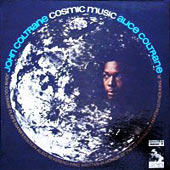
|
|
• High Tier
Coltrane only appears on two of the four tracks here - the others are post-Coltrane tracks added on to make Alice Coltrane's first album. "Manifestation" features an extremely intense Coltrane solo along with Sanders on piccolo which is a strange combination. Alice's piano couldn't be more different from McCoy's. Her touch is incredibly light - more textural than harmonic. Too bad she's buried in the mix (watch this become a common theme). "Lord, Help Me to Be" is a 1968 recording featuring a rather cool bluesy feeling with Sanders being slightly more comprehensible than normal.
"Reverend King" (aka "Peace on Earth") sees John picking up the bass clarinet for a totally nuts solo. One of the all-time underrated instruments, it's a shame that Coltrane only started experimenting (on record anyway) with instruments other than the tenor and alto in his final couple of years. On "The Sun" Alice finally gets a chance to be heard. Her piano sounds like a waterfall, and it's that glimmering quality that will be the band's secret weapon in the years to come.
An uneven release that was probably never supposed to see the light of day, it's still interesting to hear the first things the new band recorded when they went into the studio.
|
|
Live at the Village Vanguard Again!
Recorded: May 1966
Released: 1966
Label: Impulse!
John Coltrane – tenor saxophone, soprano saxophone, bass clarinet, flute
Pharoah Sanders – tenor saxophone, percussion
Alice Coltrane – piano
Jimmy Garrison – bass
Rashied Ali – drums
|

|
|
• Top Tier
The title of this record amuses me. If feels like it's saying "Oh hey, we're back again! Back for another round of jams and good times!" when the reality is that it's a completely different John Coltrane to the younger, more self-assured Coltrane that played there five years ago.
The John Coltrane on this one is grizzled, barely-hanging-on, and has a dragon in the form of Pharoah Sanders to do the intimidation work for him. "Naima" features a beautifully twisted rendition of the melody by Coltrane before we get into the long Sanders solo. Alice's piano is a highlight here, her sense of texture is just perfect. Rashied quietly builds up a storm, rather than a groove. Coltrane's solo is gorgeous. He stresses the joints of this soft ballad just enough to create tension before resolving into melody.
Leading us into "My Favourite Things" is the infamous Jimmy Garrison bass solo. There is some quite impressive playing in here, but as none of it is particularly rhythmic it may go over the heads of some listeners. As Jimmy finally arrives at an ostinato, the band comes in with some jagged lines. It's not immediately clear that this is "My Favourite Things" until John comes in with the melody right over the top of a mode that had been sitting there in wait for quite a while.
Rashied Ali is not Elvin Jones. He is what you might call "panrhythmic" - as in his rhythms don't necessarily obey any mathematical rule, they simply play everything and anything that feels right in that moment. This means that all the rhythm comes from Alice's piano, which is so much softer than McCoy's ever was, but possess a greater richness of harmony as well.
The song melts into a Pharoah Sanders solo, whilst John switches to flute, providing backing textures and Pharoah rolls out is usual MO. I think what might surprise some people is just how gentle this sounds compared to Meditations and late transition era Coltrane. This is for two reasons: 1) Alice is a light touch. That never changed. 2) Rashied Ali is also a light touch, and is down in the mix here. Rashied wouldn't remain delicate for much longer.
John makes a brief but riveting appearance on bass clarinet before switching to soprano, all the while Sanders is still belting out his solo - even briefly returning to the theme in a far more abstract manner than Coltrane's rendition in the intro. Coltrane finally takes over for his climactic soprano solo. Alice drifts off into low, rolling chords that somewhat diminish the power of the solo, but Sanders' percussion helps keep things going. The band finally hits the coda with Sanders joining in on flute. The relatively short cadenza takes on a life of its own.
Only hinting at the power that was to come, this album gives us a perfectly recorded document of the new band on stage.
|
|
Live in Japan
Recorded: July 1966
Released: 1993
Label: Impulse!
John Coltrane – tenor saxophone, alto saxophone, soprano saxophone, bass clarinet, percussion
Pharoah Sanders – tenor saxophone, alto saxophone, bass clarinet, percussion
Alice Coltrane – piano
Jimmy Garrison – bass
Rashied Ali – drums
|
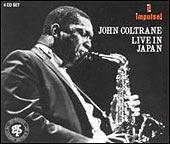
|
|
• God Tier
Well, this is it. The big one. That one album that you either dread or long for. Let's take a look at the track listing:
1. Afro Blue - 38:48
2. Peace on Earth - 26:23
3. Crescent - 54:34
4. Peace on Earth - 25:07
5. Leo - 44:50
6. My Favourite Things - 57:18
Six songs. Four discs. Four hours. That's intimidating. These are actually two full concerts in July 1966 released in one box set. The first three tracks are from the first night, and the second three from the second.
Afro Blue begins with yet another actual time signature! Rashied soon gets out of the swing of things though and back to his usual panrhythms. Coltrane's tone is like nothing you've ever heard. He is overblowing his saxophone, and the resonant frequencies are bouncing everywhere. A terrifying sound. After the melody the focus quickly shifts to Sanders who gets down and dirty without hesitation. His shrieking here is awesome to behold. Rashied slowly builds up the intensity over the top of Alice's loose comping. Eventually Alice takes over for a great solo - somehow the framework of Afro Blue always lends itself well to piano - even if it's in a freeform version. Rashied's drums really help sell the climactic moments. The rest of the song features Coltrane on what I believe is alto. Allow to repeat - his tone here is unbelievable. These are the Coltrane solos of legend - long, thunderous, and a conduit for higher powers.
"Song of Praise" opens slowly. John's melody turns into a solo where he uses a stuttering technique, blowing multiphonics on most notes. This is John and Alice's piece. Together they create an incredible soundscape that proves their relationship was - musically at least - made in heaven. Alice's piano solo traverses all sorts of terrain, but her right hand seemingly never stops with its cascade of notes. Her harp abilities spill over into her piano playing.
Another version of "Peace on Earth" opens the second concert. It is a total Coltrane showcase almost the entire way through - a tour de force of his abilities from the most intensely spiritual to the most sublimely peaceful.
"Leo" opens with John playing the melody in every possible key, much the same as in
"Acknowledgement". It soon devolves into machine gun runs of notes. Jimmy's bass is at the forefront in this section, sketching out a deep, swampy atmosphere. Rashied is going nuts on the cymbals, sounding like more than one person (as he often does). When Sanders takes over he alternates between Coltrane-sounding passages and possessed-seagull passages. This song's most prominent feature is a Rashied Ali drum solo. What's interesting is that a lot of this solo is actually perfectly composed into even time signatures - it's just that it's like someone recorded a drum solo, chopped it up and reassembeled it. Alice's, then John's solos finish out the piece.
Finale "My Favourite Things" begins with the traditional 15-minute bass solo. This one is a little more experimental - a lot of the time it seems like he's truly struggling to find a way forward, but knowing Jimmy he would have in fact been totally relaxed. It's just that this solo starts off quite unusually indeed, with lots of short, atonal phrases that are bound to confuse. However, like in "Crescent", Jimmy eventually makes his way to a passage marked by rapid-fire bursts of notes - he's obviously striking the strings with every finger on his hand. Sticking to a strict minor mode, he establishes a sort of structure that will lead us into the entry of the band in the form of a 4/4 bassline that seems astoundingly out of place in this concert. The rest of the band enters and John is in top form - his modal interrogations here some of the best you will hear. The band respond subtly to John's introduction of the main theme - quietening down for a second to allow the melody to wash over before John heads into the first solo section. Between intense machine gun sections, some of the phrases John spits out are beautifully composed - but obviously entirely improvised. Rashied's version of 6/8 is mutated but still in there somewhere. The way he transitions out of time and into free-time is something uncanny - you can never quite put your finger on when it happens but when the transition is done you can be sure of it. After a final, re-arranged statement of the main melody, Sanders steps up to the mike. His tone is a far deeper, fuller sound than John's, but you don't often get to hear it as he effortlessly jumps up to his altissimo range. I love hearing his versions of the melody - he only gets a few notes in before going off on a crazy tangent. Like Coltrane, his catchiest phrases are fantastic, and really ground the solo between the trips to other dimensions. Jimmy's bass during the solo is a big help - constantly dipping down to hit those deep foundation notes provides a much-needed counterpoint to Pharoah's textural wailing. By this time the band has settled into a deep, tight groove and Alice's solo is surprisingly one of the more conventional ones she did with the band. John's entry to his final solo on soprano is one of music's great moments. His tone is possibly better here than it would ever be again. It's a totally different sound to the one he opened up the song with, and the solo is too. It's almost like two different people. Eventually the solo heats up into a devastating barrage of notes. John sounds like a synthesizer programmed by John Cage on ecstasy. At long last the coda appears and the band reforms into a time signature. The previous 57 minutes seem like 15 minutes at most - it's a masterful rendition of their signature piece. One of the best ever.
It's the most over-the-top, excessive documents of a live performance ever, but Live in Japan easily justifies its runtime with the hypnotic, unhinged music it documents.
|
|
Stellar Regions
Recorded: February 1967
Released: 1995
Label: Atlantic
John Coltrane – tenor saxophone, alto saxophone on Tranesonic
Alice Coltrane – piano
Jimmy Garrison – bass
Rashied Ali – drums
|
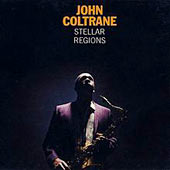
|
|
• Top Tier
"Serraphic Light" begins with the rich, deep tone of Coltrane's tenor in full force. Compared to the Japan concerts of ‘66 he is far more composed and focused. The rest of the band sounds crystal clear on this fantastic recording. (No Pharoah on this session.) "Sun Star" opens with a beautiful free-form section where Jimmy bows his bass to great effect. In fact Jimmy's presence on this album is more prominent than it has been for years.
"Stellar Regions" and "Iris" sound more preplanned than other recent recordings - but Coltrane is exploring modes and phrases that are way outside of his normal comfort zone. Album centrepiece "Offering" explores yet another possibility of the "Acknowledgement" opening section - the first few notes are a quote from that song. The first section of this song is extremely reserved - and sparse. However the bass and piano drop out and leave just John supported by Ali. This is one of the most intense examples of John's playing in his whole career. He attacks runs of notes with unbelievable aggression and speed.
"Configuration" begins with a wonderful drum and sax duet - very similar to "Countdown" all those years ago. "Jimmy's Mode" has a curious intro and outro where John and Alice are uncharacteristically in unison - the majority of the song is a typically avant-garde bass solo. "Tranesonic" opens with a flourish of atonal notes from John and proceeds into a shambolic, tumbling mess of sound - hearing the rapport between Coltrane and Ali however is a privilege.
This long-lost session is a cornerstone of Coltrane's studio recordings and is not to be missed.
|
|
Interstellar Space
Recorded: February 1967
Released: 1974
Label: Impulse!
John Coltrane – tenor saxophone, percussion
Rashied Ali – drums
|
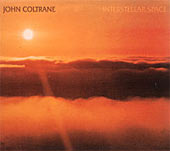
|
|
• High Tier
After years and years of flirting with the concept, John finally sits down to record a whole session of just drums and sax. That relationship has always been the dominating one in John's music going right back to Giant Steps. Although John is propelled upwards by the piano and grounded by the bass, it's always been the drums that have provided that in-the-moment inspiration - and vice-versa. This album however does not fulfil the potential of its concept.
Apparently Rashied was only told when he turned up to the studio that it would just be him and John that day, and that he thought he could have done better had he been more prepared. I think so too, but that doesn't diminish in the slightest the power of these recordings. John is heavily into his machine gun bursts here, and Rashied plays frantically, particularly on the snare. The recording itself is somewhat muted though - turn this all the way up to appreciate it.
All these songs are very similar in that they begin with a very short, very abstract "theme" and then progress through multiple solo ideas, interspersed with percussion sections. John starts and finishes each track with a shake of sleigh bells. Out of them, it's probably "Venus" and "Jupiter" that nail the concept the best, although "Leo" is a tour de force despite it's length.
This is a difficult album to sit down and listen to in one go, and I think it could have done with being dispersed through other more fully-instrumented albums, but even as a document of an idea in a moment of time, it's fascinating and a great and welcome change from the usual instrumentation.
|
|
Expression
Recorded: February to March 1967
Released: 1967
Label: Impulse!
John Coltrane – tenor saxophone, flute
Pharoah Sanders – flute, piccolo
Alice Coltrane – piano
Jimmy Garrison – bass
Rashied Ali – drums
|
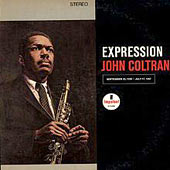
|
|
• Top Tier
This album collects the last few recordings Coltrane ever made in the studio. Opener "Ogunde" reveals the most incendiary tone yet achieved by Coltrane. It's truly astounding that even in his final days he was evolving his sound, dropping what didn't work and sharpening what did. "To Be" is unique in that it features Coltrane and Sanders on flute and piccolo respectively. John's flute work is lovely, his ghostly tone benefits from the fact that it's not his normal instrument. Jimmy and Rashied create an intense, exotic atmosphere. The band sound like they're deep in the jungle.
"Offering" from the Stellar Regions sessions also appears on this record, but it's such a thrilling piece that I dare not skip it. "Expressions" reaches incredible heights with an earth-shattering Coltrane solo backed by some of Alice's finest ever playing. "Number One" goes in intense and keeps on going. The band here is in total sync. Everyone is listening and responding to each other. Just glorious.
One of the finest late era albums - in fact it's only the length of "To Be" that lets the album down. Everything else is golden.
|
|
The Olatunji Concert: The Last Live Recording
Recorded: April 1967
Released: 2001
Label: Impulse!
John Coltrane – tenor saxophone, soprano saxophone
Pharoah Sanders – tenor saxophone
Alice Coltrane – piano
Jimmy Garrison – bass
Rashied Ali – drums
Algie Dewitt – percussion
|

|
|
• God Tier
John Coltrane's final recording is the sound of a man about to die.
After a low-key introduction, the band lurches into "Ogunde". John's incredible tone is blunted somewhat by the crude recording quality. What really benefits though, is Rashied's drums, which on this recording are enormous. They will rattle your headphones to the core - every hit of the snare and cymbal is just so LOUD that you will think there is something wrong happening.
John quickly steps down from the mic and Sanders enters. Unbelievably, he is drowned out for the first time in his life by Rashied. Jimmy can be heard clearly in the bottom end providing a counterpoint to Rashied's chaos. Alice is in there somewhere too, but it's more difficult to make out - there are chords here and there but nothing distinct. Within minutes the song builds up to an intensity you can hardly believe. It's harsh - it's aggressive - it's not easy to listen to. But if you're in this from the beginning you won't be able to rip your attention away.
Finally Sanders subsides and Alice gets an uncharacteristically audible solo. Jimmy is loud here too - you get the sense they brickwalled the audio to make the most of a crappy recording. When John comes back the band is back to almost full force. His playing is confident and authoritative. Despite the incredible volume, there is no anger or frustration here. This is the sound of a man who has tentatively found peace. The importance of the band's communication here cannot be understated. Yes, they're making a cacophany, but they're obviously listening intently to each other. Jimmy is 100% in sync with Rashied - it took a while for the drums/bass relationship to reach perfection but they got there.
The song ends with a thunderous cadenza - one of John's best. Jimmy quickly launches his bass solo. He sounds remarkably good here - a very full and warm recording. Jimmy is more dexterous than usual tonight. As usual, his arrival at an ostinato means that the band is ready to come in. They enter with such force that it sounds like they are being put through a distortion pedal. John hits some incredible runs on his soprano, reacting with precision to the movements of Alice and Rashied. As the drums build, John plays with more and more reckless abandon - although somehow it's still obvious that he's in control of himself.
After briefly quieting, John grazes the main melody - only just. Then Sanders begins what is to my ears his most abrasive solo, ever. It's ear-splitting stuff, amplified all the more by the bed of chaos going on around him. After he's done, he actually makes a more coherent statement of the theme than John does. John returns in full synthesizer mode. Alice's playing has picked up too, and her strong chords hark back to the original recording. John's solo is one for the ages - the ultimate swan song for a legendary career. The traditional coda closes the song amidst some terrifying drum fills.
And just like that, it was all over. Coltrane walked onto the stage one more time a month later (God knows what I'd pay to hear a recording of that gig) and then never again. His liver was hurting him by May, and by August he had succumbed to liver cancer. Many had no idea he was ill.
This recording is the best possible send-off for a man who was never ever satisfied with now - he only ever thought about what he would be playing at his next concert - how his sound would evolve to realize that vision. And this concert is yet another perfect example. Imperfect - but a meaningful experience that will leave you shaken.
|
|
Infinity
Recorded: Posthumously in 1972
Released: 1972
Label: Impulse!
The Classic Quartet – "Living Space", "Joy"
The Final Quintet + Ray Appleton (perc.) – "Peace on Earth", "Leo"
Assorted overdubbing musicians
|

|
|
• High Tier
This is one of those odd "remix" albums that typically fall outside the artis's established chronology. This album takes two Transition-era recordings and two final-era recordings and sets them to lush overdubs courtesy of Alice Coltrane, Charlie Haden, Joan Chapman, and more.
"Peace on Earth" sees the original recording drowned out by huge strings and Alice's harp. John's tone is muted somewhat by all the extra layers, but they do a good job of bringing out the inherent melody in John's solos.
"Living Space" opens with a Strauss-sounding intro - transplanted into what may as well be an orchestra, John sounds more at home than you'd think. Although the piano solo during the middle sounds distant, the beginning and end are great. The strings get stranger on "Joy" - their ever-rising pitches don't do the song many favours in my opinion.
"Leo" opens with psycho strings to accompany John's stark, octave-leaping intro. The timpani solo though is a nice touch - if only Elvin had experimented with it! We also get treated to a sweet electric piano solo which is an anachronism in the Coltrane discography.
Although this album is pretty flawed, it does a fine job of making us wonder where Coltrane may have gone had he continued making music. It's my opinion though that there is no universe in which Coltrane would continue making music.
1967 was the end - death or no death. Coltrane had found a small peace that had never been a part of his music until then. In this final era of his life, Coltrane played like a man about to die - a man who knew he had limited time to tick off his musical bucket list in. It's the most challenging, but most rewarding period of Coltrane's discography, and one that I will always revere more than just about any music out there.
Rest in Peace, John Coltrane.
1926-1967
|
Part 1 Part 2 Part 3 Part 4 Part 5 Part 6
|
|